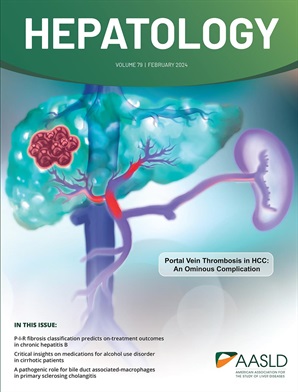Hepatocyte-derived extracellular vesicles promote endothelial dedifferentiation in chronic liver disease through the miR-153-3p – pyroptosis axis
IF 15.8
1区 医学
Q1 GASTROENTEROLOGY & HEPATOLOGY
引用次数: 0
Abstract
Background & Aims: Liver cells communicate paracrinally through extracellular vesicles (EVs). This study investigated the role of miRNAs embedded in hepatocyte derived EVs (hepEVs) modulating endothelial cell dedifferentiation in chronic liver disease. Methods: EVs were purified from primary hepatocytes isolated from healthy (CT) and cirrhotic (CH) livers in both humans and rats. CT-rats were intravenously treated with fluorescence-labelled hepEVs-CT or hepEVs-CH (200 μg/d, 3 d, n=10/group) to assess biodistribution and liver sinusoidal endothelial cells (LSECs) phenotype. miRNA profiling of human hepEVs-CH was validated in rat models, and commonly altered miRNAs were over-expressed in CT-LSECs. Gene dysregulation was analysed in primary CH-LSECs and liver tissues from rats and humans with cirrhosis, as well as CT-LSECs treated with miRNA-specific upregulated hepEVs. CH-rats were treated with the Caspase-1 inhibitor VX-765 (15 mg/kg/d, 10 doses, n=11/group) to evaluate its effects on liver function, haemodynamics, and endothelial phenotype. Results:肝细胞来源的细胞外囊泡通过miR-153-3p -焦亡轴促进慢性肝病内皮细胞去分化
背景和目的:肝细胞通过细胞外囊泡(EVs)进行细胞旁交流。本研究探讨了嵌入肝细胞源性ev (hepEVs)中的miRNAs在慢性肝病中调节内皮细胞去分化的作用。方法:从人和大鼠健康肝脏(CT)和肝硬化肝脏(CH)分离的原代肝细胞中纯化ev。采用荧光标记hepEVs-CT或hepEVs-CH (200 μg/d, 3 d, n=10/组)静脉注射ct大鼠,观察肝窦内皮细胞(LSECs)的生物分布和表型。在大鼠模型中验证了人hepev - ch的miRNA谱,并且在CT-LSECs中常见改变的miRNA过表达。在原发性CH-LSECs和肝硬化大鼠和人的肝组织中,以及用mirna特异性上调的hepev处理的CT-LSECs中,分析了基因失调。用Caspase-1抑制剂VX-765 (15 mg/kg/d, 10剂,n=11/组)治疗ch -大鼠,评估其对肝功能、血流动力学和内皮表型的影响。结果:在体内,hepEVs-CH主要在LSECs中积累,破坏参与纤维化、炎症和细胞死亡的基因,同时增强vWF表达并改变eNOS活性。人hepEVs-CH的分析显示37个mirna失调,miR-200a-3p和miR-153-3p在大鼠hepEVs-CH中得到验证。将miR-153-3p转染到CT-LSEC中,会使参与炎症和细胞死亡,特别是焦亡的771个基因失调。在人和大鼠肝硬化肝组织中,以及用miR-153-3p-hepEVs处理的CT-LSEC中,观察到活性Caspase-1和Gasdermin-D表达增加,表明焦亡增强。在体内,VX-765治疗减少了肝焦亡,改善了内皮表型和门静脉高压。结论:hepev衍生的mirna,特别是miR-153-3p,通过旁分泌机制触发焦亡,有助于CLD内皮功能障碍。抑制Caspase-1可能为缓解CLD的内皮功能障碍提供一种新的治疗方法。
本文章由计算机程序翻译,如有差异,请以英文原文为准。
求助全文
约1分钟内获得全文
求助全文
来源期刊

Hepatology
医学-胃肠肝病学
CiteScore
27.50
自引率
3.70%
发文量
609
审稿时长
1 months
期刊介绍:
HEPATOLOGY is recognized as the leading publication in the field of liver disease. It features original, peer-reviewed articles covering various aspects of liver structure, function, and disease. The journal's distinguished Editorial Board carefully selects the best articles each month, focusing on topics including immunology, chronic hepatitis, viral hepatitis, cirrhosis, genetic and metabolic liver diseases, liver cancer, and drug metabolism.
 求助内容:
求助内容: 应助结果提醒方式:
应助结果提醒方式:


